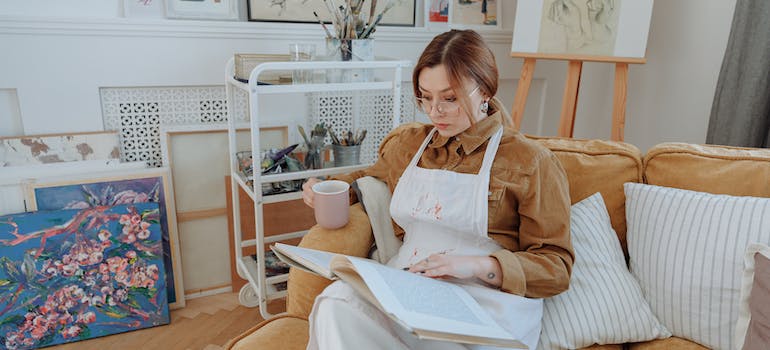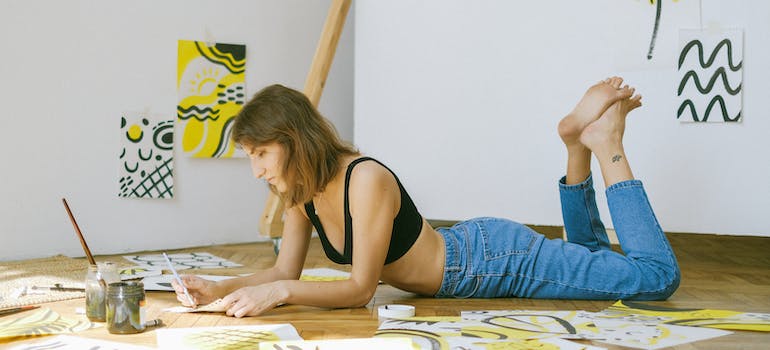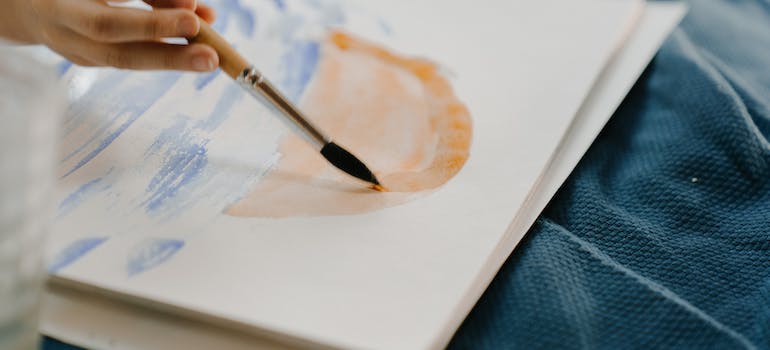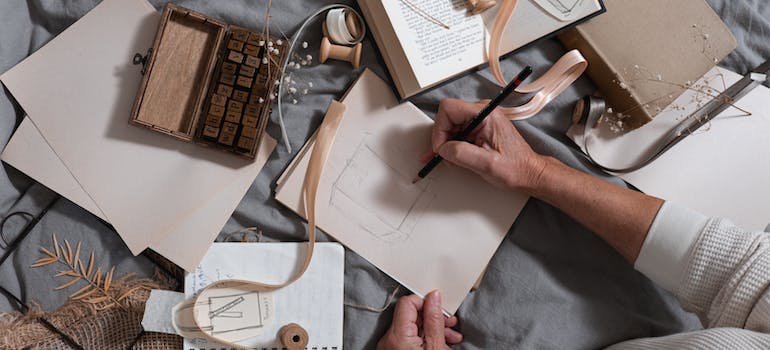In a world where words can sometimes fall short, art serves as a canvas for our innermost thoughts and emotions. Whether you consider yourself an artist or not, art therapy provides a non-judgmental space to reflect on your inner world. It can help you understand your thoughts and feelings deeply. In this blog post, Harmony Ridge Recovery Center explores the transformative nature of art as a therapeutic tool and how reflecting inner thoughts through art therapy can bridge the unspoken and the understood in the journey toward self-discovery and healing from addiction.
What Is Art Therapy?
Art therapy is a form of psychotherapy that utilizes the creative process of making art to improve mental, emotional, and physical well-being. It involves the use of various art materials and techniques to help you explore, express, and understand your thoughts and feelings. Unlike traditional talk therapy, art therapy in WV goes beyond verbal communication, allowing individuals to convey their inner experiences through visual, tactile, and sensory means.

During an art therapy session, a trained art therapist provides a supportive environment where individuals can engage in artistic activities such as drawing, painting, sculpting, or even using other forms of creative expression like collage or photography. The focus is not on creating a masterpiece but on the process of creation and the emotions that arise during that process.
Art therapy can be particularly beneficial for those who find it challenging to express themselves verbally or for individuals dealing with co-occurring mental health disorders, such as:
- trauma and addiction
- Post Traumatic Stress Disorder
- stress
- anxiety disorders
- other mental health issues, such as severe depression
It offers a non-threatening way to explore and confront difficult emotions, enabling individuals to gain insights, develop coping mechanisms, and promote personal growth.
The Role of a Therapist During Art Therapy for Addiction
Art therapists guide the expression of inner thoughts through art in a supportive and gentle way. They create a safe space where you can freely explore your feelings using different art materials. The process involves these key steps:
- Materials and Options: Therapists offer a variety of art materials like pencils, paints, or clay. They might also suggest different techniques. The idea is to let you choose what feels right for expressing your thoughts.
- Encouragement, Not Judgment: Therapists encourage you to create without worrying about making things perfect. There’s no right or wrong in art therapy – it’s about expressing yourself. They provide positive feedback to help you feel at ease.
- Exploring Emotions: Through the art-making process, therapists may ask questions about your creation, encouraging you to reflect on the colors, shapes, or textures you’ve chosen. This exploration helps you connect with and understand your emotions.
- Metaphors and Symbols: Therapists might talk about how elements in your artwork could symbolize different aspects of your thoughts or experiences. This helps in uncovering deeper meanings and gaining insights into your feelings.
- Narrative Building: As you work on your art, therapists may ask you to share the story behind it. This narrative-building process allows for a verbal expression of your emotions, connecting your inner thoughts with the artwork.
- Processing Together: The therapist and you work together to process the emotions that arise during the art-making. They help you recognize patterns, strengths, and coping strategies, fostering a deeper understanding of your thoughts.
How Does Art Therapy Help in Treating Mental Health Issues?
Art therapy is becoming more important in helping with different mental health challenges. It’s a unique way for people to express themselves and feel better.
For example, when people feel anxious or stressed, it can be hard for them to talk about what’s bothering them. Art therapy gives them a way to show their feelings through pictures and shapes. Together with your therapist, you can figure out what’s stressing you and how to deal with it.

In depression, people use abstract art to express themselves. Therapists notice that when the colors in their art become brighter, their mood often improves. Studies show that doing art therapy can help lessen depressive symptoms.
For those who have been through trauma, art therapy is like a special tool. It helps survivors talk about their difficult experiences, even if they can’t put it into words. Studies say art therapy is effective in helping people recover from trauma and become emotionally stronger.
People struggling with self-esteem and body image issues also find comfort in art therapy. Drawing or creating visual art about how they see themselves helps improve their self-esteem. Research suggests that art therapy has a positive effect on how they view their bodies.
How Does Art Therapy Help in Treating Addiction?
Art therapy serves as a valuable tool in the treatment of addiction by facilitating self-expression, emotional release, and psychological healing in a non-verbal manner. This therapeutic approach integrates the creative process of art-making with professional support in order to:
- explore personal feelings
- reconcile emotional conflicts
- foster self-awareness
- manage behavior
- develop social skills
- reduce anxiety
- increase self-esteem
Benefits of Art Therapy in Addiction Treatment
In the context of addiction treatment, art therapy is particularly beneficial for several reasons:
- Enhanced Self-Expression: Many individuals struggling with addiction find it challenging to articulate their thoughts and emotions verbally. Art therapy offers an alternative means of expression, allowing clients to convey their feelings and experiences through visual and tactile forms. This process can unearth underlying issues contributing to addictive behaviors, such as trauma, stress, or unresolved emotional conflicts.
- Emotional Regulation and Insight: Engaging in art-making can have a meditative effect, helping individuals to focus on the present and momentarily detach from the stressors and triggers of addiction. Through reflection on their artwork, clients can gain insights into their emotional states and behavioral patterns, promoting a deeper understanding of the root causes of their addiction.
- Stress Reduction and Coping Skills: The act of creating art is inherently therapeutic and can significantly reduce levels of stress and anxiety. For individuals in recovery, developing new, healthy ways to cope with stress is crucial. Art therapy provides a constructive outlet for coping with difficult emotions and situations, reducing the likelihood of relapse.
- Enhanced Self-esteem and Identity: Addiction often erodes an individual’s sense of self-worth and identity. Art therapy can help rebuild this sense of self by providing a tangible sense of accomplishment through the creation of artwork. It also allows individuals to explore and express aspects of their identity in a supportive environment, aiding in the construction of a positive self-image.
- Social Skills and Communication: Group art therapy sessions offer opportunities for social interaction, fostering a sense of community and support among participants. These interactions can enhance communication skills, empathy, and mutual support, all of which are important for recovery and rehabilitation.
- Integration with Other Treatment Modalities: Art therapy can be seamlessly integrated with other therapeutic approaches, such as:
Art therapy combined with other addiction treatment approaches helps create a comprehensive treatment plan. It supports the therapeutic goals of these modalities by facilitating emotional expression and insight, which can be further explored in traditional therapy sessions.
How Can Art Help Us Understand Our Thoughts and Emotions?
Art helps us understand our thoughts and emotions by providing a visual and tangible representation of what’s going on inside us. Instead of just talking about it, art allows us to externalize our inner experiences, making them more concrete and manageable. When we look at our artwork, it becomes a mirror reflecting our psychological states – the colors we choose and the shapes we create all carry meanings that can reveal aspects of our emotions and thoughts. It’s like decoding a visual language that speaks to our subconscious.
In this way, art becomes a unique window into our psychological states and subconscious thoughts. Sometimes, what we create spontaneously in art can surprise us, revealing aspects of ourselves that we might not have been fully aware of. The process of making art can bring these hidden thoughts and emotions to the surface, offering insights and a deeper understanding of our inner world.
How to Find Art Therapy?
If you’re interested in trying art therapy, there are several easy ways to get started. Many communities have art therapists or mental health professionals who offer art therapy sessions. You can check with local counseling centers, community centers, or addiction treatment facilities in West Virginia to see if they have these services available.
If you prefer doing it on your own, you can find plenty of resources online. There are websites and apps that provide guided art activities specifically designed for therapeutic purposes. You don’t need to be an expert artist – these resources are meant for everyone, regardless of skill level.

Art therapy books are another helpful resource. You can find books that guide you through different art exercises to explore your emotions and thoughts. These books often explain the therapeutic benefits of each activity and how to get the most out of them.
Lastly, consider joining art therapy groups or workshops in your community. These groups provide a supportive environment where people come together to engage in art activities and share their experiences. It’s a great way to connect with others who are also using art as a form of self-expression and healing.
Art Therapy at Harmony Ridge
At Harmony Ridge, art therapy emerges as a pivotal component of addiction treatment, embracing the belief that creative expression is a powerful conduit for healing and recovery. The program recognizes that the complexity of addiction often stems from underlying issues such as poor mental health. Consequently, the integration of art therapy aims to address these core concerns by promoting both mental and physical well-being.
Understanding Art Therapy at Harmony Ridge
Art therapy at Harmony Ridge is not confined to traditional artistic endeavors like painting or music; it encompasses a broad spectrum of creative expressions. This inclusive approach acknowledges that art, in its myriad forms, can serve as a therapeutic tool. Activities within the art therapy program may include:
- painting
- sketching
- knitting
- sculpting
- playing or listening to music
- dancing
- drawing
- acting
- poetry
- collaging
- scrapbooking
- coloring
- graphic journaling
This diversity ensures that all individuals can find a mode of expression that resonates with them, facilitating a more personalized and effective therapeutic experience.
Mental Health and Addiction Treatment Benefits
Harmony Ridge’s art therapy program is designed to leverage the inherent benefits of artistic expression to support addiction recovery. Key advantages include:
- Dopamine Release: Engaging in art activities can stimulate the natural release of dopamine, a neurotransmitter associated with pleasure and reward. For individuals recovering from addiction, this natural stimulation is crucial for restoring brain chemistry affected by substance abuse.
- Self-Discovery: The creative process allows individuals to explore their identities and understand themselves better. This exploration is especially valuable for those who may have lost a sense of self to addiction.
- Fostering Change: Art therapy encourages openness and self-reflection, creating a conducive environment for considering life changes. This reflection is vital for individuals ready to embrace recovery and make positive life adjustments.
- Self-Expression: The program offers a safe space for expressing emotions and experiences, often leading to significant therapeutic breakthroughs. This expression is particularly important in a society where such openness is not always encouraged or accepted.
- Self-Esteem Enhancement: Completing an art project provides a sense of achievement, contributing to improved self-esteem. For individuals battling mental health issues alongside addiction, such accomplishments can be profoundly uplifting.
- Career Pathways: For some, art therapy unveils talents and interests that may lead to new vocational opportunities, further enhancing self-esteem and providing a positive outlook on life.
Collaborative and Individualized Approach
Harmony Ridge’s art therapy sessions are tailored to the individual, taking into account personal preferences and interests. The focus remains on the therapeutic process rather than the end product, allowing for a more meaningful and personal journey through recovery. Participants retain ownership of their creations, highlighting the program’s respect for individual expression and achievement.
Comprehensive Care Model
Recognizing the importance of a multifaceted approach to addiction treatment, Harmony Ridge complements art therapy with a range of other therapeutic modalities. This integrated approach ensures that all aspects of an individual’s recovery journey are supported, including:
- detoxification program using medication assisted treatment
- inpatient rehabilitation
- outpatient programs
- partial hospitalization
Access and Support
Harmony Ridge collaborates with major insurance providers, making art therapy and other treatment services accessible to those in need. We accept:
- Humana rehab coverage
- BCBS rehab coverage
- FMLA rehab coverage
- Tricare rehab coverage
- PEIA rehab coverage
The center’s commitment to evidence-based, individualized care positions it as a leading choice for those seeking recovery support in West Virginia and Mid-Ohio.

Art therapy for addiction contributes significantly to the treatment of addiction by offering a unique and effective means of self-expression, emotional regulation, and psychological healing. Its ability to be integrated into a holistic treatment plan makes it an indispensable tool in addressing the complex needs of individuals recovering from addiction.
Reflecting Inner Thoughts through Art Therapy at Harmony Ridge
Exploring and reflecting inner thoughts through art therapy can be a rewarding and transformative journey. Art serves as a powerful language to express feelings that might be challenging to put into words. Whether you engage in art therapy with a professional, use online resources, or join a local group, the essence remains the same: expressing yourself creatively can be a valuable tool for self-discovery and healing.
Discover the transformative power of art therapy at Harmony Ridge, where creativity meets healing in the journey toward recovery. Whether you’re navigating the challenges of addiction or seeking a deeper connection with your mental well-being, our art therapy program offers a unique path to self-discovery and healing. With a wide range of artistic expressions catered to your personal preferences and interests, Harmony Ridge provides a supportive environment for everyone. Don’t let addiction define your story. Take the first step towards a brighter, healthier future by contacting Harmony Ridge Recovery Center today. Embrace the healing journey through art therapy and experience how creative expression can unlock the door to recovery. Your path to renewal begins here—reach out to us and explore the possibilities that await you at Harmony Ridge.



